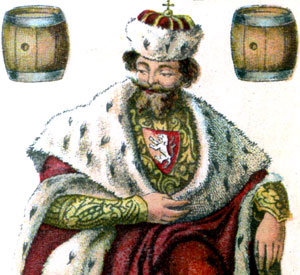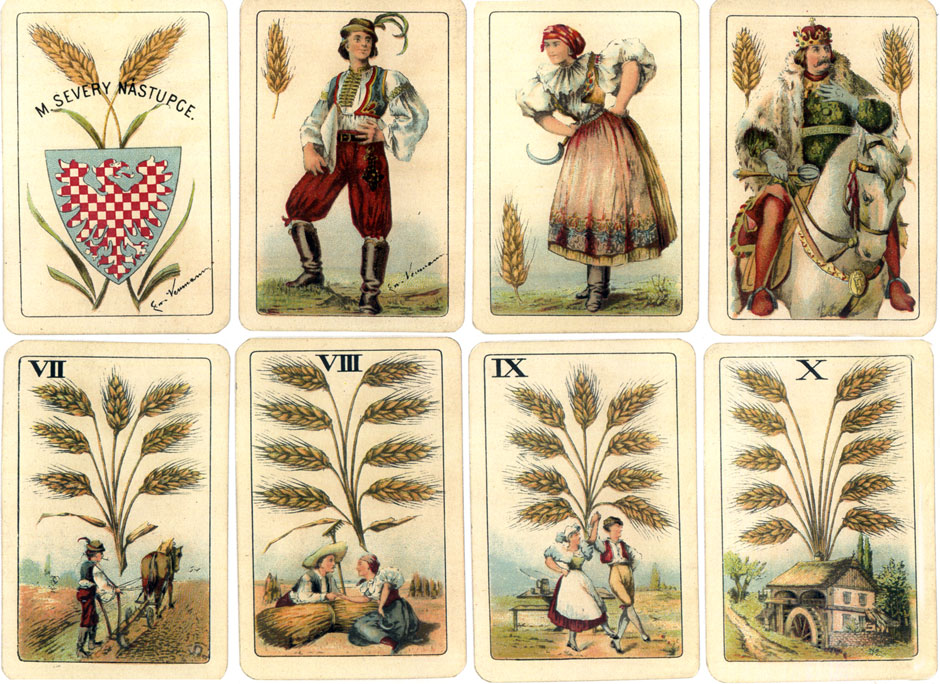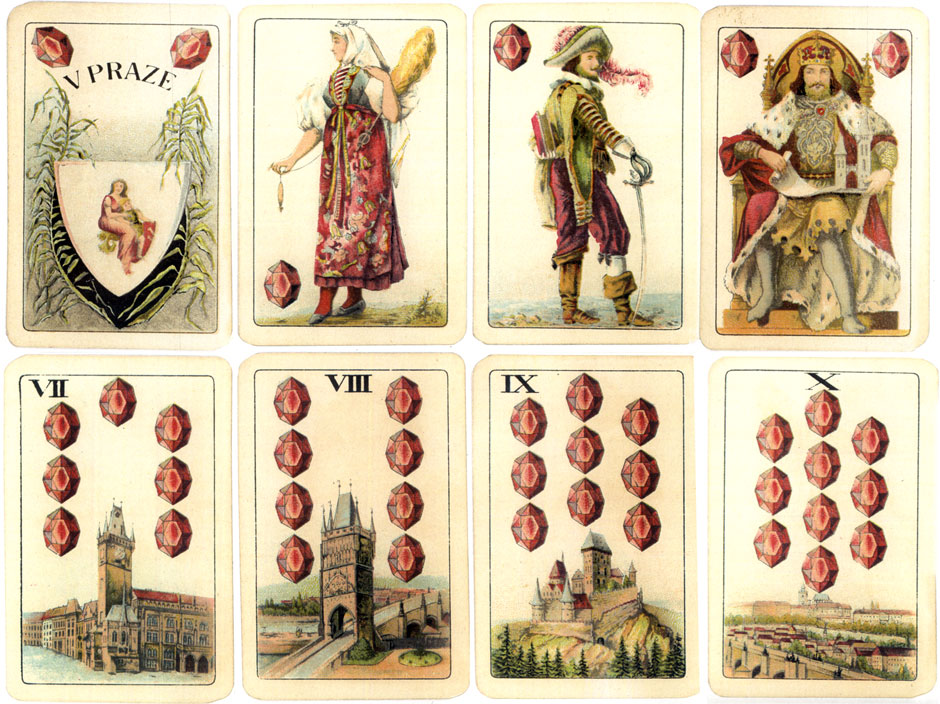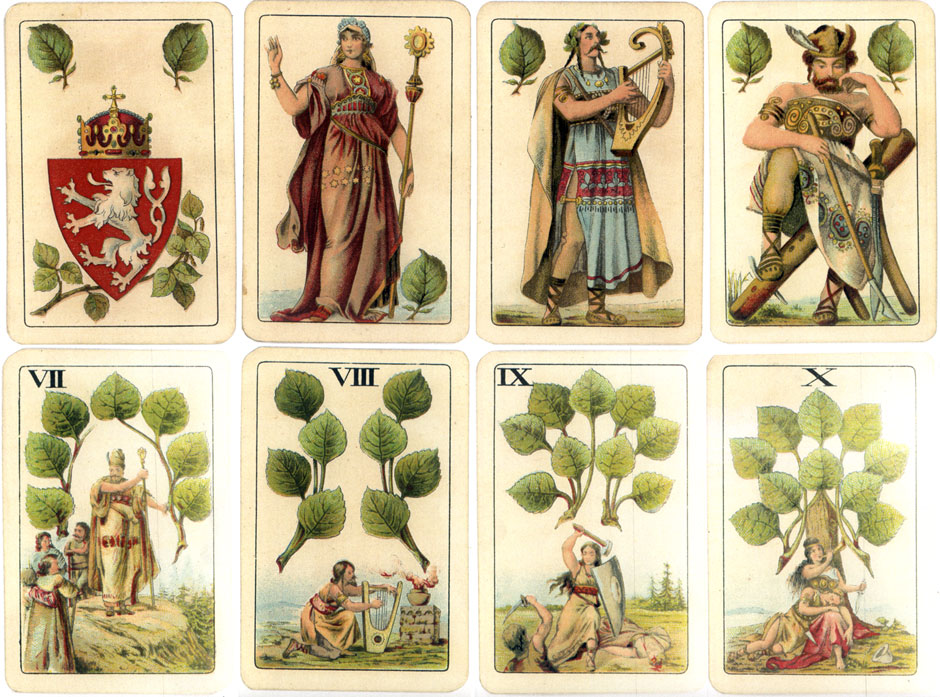Czech Nationalistic playing cards
During the 19th century growing nationalist sentiment led to a rejection of Austro-Hungarian culture in favour of that of the native Czech people. One outcome from this movement was a ‘Nationalistic’ pack of playing cards painted by Emanuel Neumann.

designed by Emanuel Neumann, c.1895
During the 19th century growing nationalist sentiment led to a rejection of Austro-Hungarian culture in favour of that of the native Czech people. One outcome from this movement was a ‘Nationalistic’ pack of playing cards painted by Emanuel Neumann in which the standard national suit symbols are replaced with non-standard ones having particular meaning to the Czech people. Ears of corn, or Sheaves, replace Acorns symbolising the fertility of agriculture and the Czech lands. Deep red Garnets, which replace Hearts, have reputed healing powers. Wine Kegs replace bells to celebrate viniculture in Bohemia and Moravia that was started by the Romans. Lime Leaves are from the national tree of the Czech lands. The cards were made in an effort to raise national self-confidence and esteem.

The suit of Ears of Corn features workers in the fields ploughing, harvesting and celebrating. The Upper Jack shows a man in traditional Moravian dress, and the King is George of Podebrad, the last King of an independent Bohemia. The signature of the artist who painted the cards, Emanuel Neumann (1873-1932), can be seen on the Upper Jack and the daus (2) which also shows the Moravian eagle on a shield. Manufactured by Anton Kratochvíl, Prague.

The suit of Garnets features Charles IV as the King, "Father of the Nation". The lower Jack is a female weaver. whilst the VIII of garnets shows the old town bridge. The daus card (2) depicts a mother and child, symbolising maternity and the founding of the nation, with an inscription which means 'In Prague'.

The suit of Wine Barrels features the Silesian eagle on the daus while the Lower jack shows a woman in traditional Bohemian dress. The numeral cards show scenes such as vineyards and people toasting. The VIII has the Austro-Hungarian tax stamp along with the maker's stamp.

The suit of Lime Leaves features scenes from Czech history and mythology. The King is the farmer Premsyl who married Queen Libussa who is shown as the Lower Jack. The IX shows a scene from the legend of Sharka. On the daus card (2) we see the heraldic Czech two-tailed lion.
REFERENCES
Šťáhlavsky, Zdenĕk: "A 19th Century Czech Nationalistic Pack by Emanuel Neumann", The Playing-Card vol.32 no.6, May-June 2004, IPCS, England.
• See also: 1908 Prague Jubilee Exhibition • 'Jugendstil' designed by Artuš Scheiner, 1920 • Ritter & Cie "Art Deco", 1933 • Eagle Playing Card Co., Ltd.

By Simon Wintle
Member since February 01, 1996
I am the founder of The World of Playing Cards (est. 1996), a website dedicated to the history, artistry and cultural significance of playing cards and tarot. Over the years I have researched various areas of the subject, acquired and traded collections and contributed as a committee member of the IPCS and graphics editor of The Playing-Card journal. Having lived in Chile, England, Wales, and now Spain, these experiences have shaped my work and passion for playing cards. Amongst my achievements is producing a limited-edition replica of a 17th-century English pack using woodblocks and stencils—a labour of love. Today, the World of Playing Cards is a global collaborative project, with my son Adam serving as the technical driving force behind its development. His innovative efforts have helped shape the site into the thriving hub it is today. You are warmly invited to become a contributor and share your enthusiasm.
Related Articles

Czech National Patterns by S.D. Modiano
Modiano produced cards with the Prague and Trappola patterns in the early 20th century.

Doppel-Deutsche Karten by Bratří Willnerové, Teplice
This deck from local manufacturer Bratří Willnerová offers a standard version of the popular Central...

Prager Pattern by Bratří Willnerové, Teplice
Traditional single-ended Prager pattern by Willner Brothers from northern Bohemia.

Animal Skat, Česká Grafická Unie
A non-standard deck from Czechoslovakia.

Virgil Solis
Remarkable pack of 52 animal-suited playing-cards designed and etched by Virgil Solis.

Czech Bohemian style playing cards
Czech Bohemian style playing cards with a charming aesthetic, reflecting the cultural and social lif...

Classification of Numeral Card Designs in French-suited packs
The classification of numeral cards in French-suited packs, covering various pip designs in over 400...

Why our playing-cards look the way they do
Analysis of early playing card designs: origins, suit differences, standardization, technological ad...

Laughing Made Easy
a Victorian card game published by D. Ogilvy.

Commoners playing cards
Created by Ian Cumpstey dedicated to the common land and the countryside.

Postak – Las Postas
‘Postak - Las Postas’ playing cards commemorating the history of the Basque postal service, Spain, 1...

ČZ playing cards
Advertising pack for the Czechoslovak motorcycle factory Česká Zbrojovka.

Bischofszell
Advertising pack for the food producer Bischofszell, designed by Heinz Looser-Brenner, with non-stan...

Marcello Morandini
Modern designs by Italian artist Marcello Morandini using the simplest of forms and colours.

Heathen Wars
German-suited ‘Heathen War’ playing cards published by Joseph Fetscher, Munich, c.1820.

Costumes of Turkey Tarot
‘National Costumes of Turkey’ tarot by Industrie Comptoir, Leipzig, c.1800-1825.
Most Popular
Our top articles from the past 28 days

